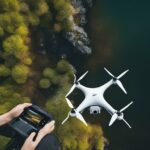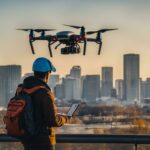In the realm of drone tech, comprehension of wind resistance factors is imperative. This piece delves into the complexities involved in quantifying drone capabilities against strong winds and elements affecting its resilience to such conditions – limitations and precautions included. It also provides guidance on how best to navigate drones when facing blustery climates.
A scale ranging from 0-12 gauges wind resistance levels for these devices; grasping this key information about a particular model’s capacity is vital, especially before using it beyond its operational scope under windy circumstances.
Get valuable insights necessary for securely handling drones while ensuring optimal performance even when confronted with challenging meteorological scenarios.

Key Takeaways: Drone Wind Resistance Levels
- The degree of wind resistance in a drone is represented through values ranging from 0 to 12, indicating the maximum velocity of winds it can efficiently counteract.
- Persistent strong gusts have potential implications on the steadiness and safety of navigating drones by leading to instability or possible harm.
- The efficiency with which drones resist wind factor comes down to variables such as weight, dimensions, aerodynamic design/features, engine strength/efficiency as well as sensory equipment incorporated within their systems/projects/components, etc.
- It remains critical for operators/end-users/operators/commercial users must consider prevailing/pre-recorded/project-measured mirrored camshaft position (CMP)/wind velocities before flight initiation thus steering clear off winds measured at two-thirds higher than peak speed capability/configuration variable/analog accessible mission parameters.
The Importance of Drone Wind Resistance Levels
Without a doubt, realizing the significance of drone wind resistance is pivotal for safe handling and operation in diverse meteorological settings. It’s absolutely necessary that drones have strong wind tolerance to maintain balance and command during flight.
Drones with lesser weight come packed with numerous benefits during windy landscapes. Their lighter mass makes them more responsive towards gusts of winds enabling easier position maintenance and equilibrium. Also, such lightweight drones face decreased air opposition, which minimizes stress on engine components as well as power storage units – thus enhancing battery longevity resulting in lengthier fly periods.
Understanding the Beaufort Scale and Its Relation to Drone Wind Resistance
Intriguingly, the Beaufort Scale offers a useful model for grasping drones’ wind resistance abilities and their correlation to varying wind velocities.
The historic importance of the Beaufort scale in marine navigation cannot be undermined. This usual classification system labels windspeed into 12 groups ranging from tranquil (0) to hurricane-strength(12). These groupings have direct ties with the drone’s levels of resisting wind,
There is an important connection between these resistance standards against gusts and the overall performance metrics of all engineered aerial machines or drones. When drones exhibit higher endurance towards substantial waves of air currents, they assure greater stability along with healthy control mechanisms paving the way forward for maintaining both altitude as well direction even amidst potentially tough windy conditions.
Understanding nuances around leveraging The Beaufort Framework while evaluating how this integrates within your own business use-case scenarios is critically important if you are looking at accomplishing flight operations safely and efficiently—especially within inconsistent frames that comprise volatile weather patterns.
Effects of Strong Winds on Drone Flight
Operating unmanned aerial vehicles in heavy winds might negatively influence their flying capacity, triggering erratic movements and potential harm or accidents. Sturdy wind blasts may deviate the drone from its course, leading to unexpected maneuvers and a decline in control.
Moreover, strong air currents near large geographical structures could make the drone ascend unexpectedly. To counter such events, it is essential to incorporate specific strategies for operating under windy conditions.
A suggested tactic includes piloting below the preset wind resistance level of the UAV which enables rapid repositioning by offsetting external forces. It’s also advisable not to fly when facing breezes about 2/3 times stronger than your device’s top speed as this can lead to unregulated trajectory shift.
{NewParagraph}
In addition to these practices, maneuvering into downward drafts or along with airstream direction helps conserve energy while opting for lower elevation flight can decrease both the intensity of gusts met plus battery consumption.
Factors Influencing Drone Wind Resistance
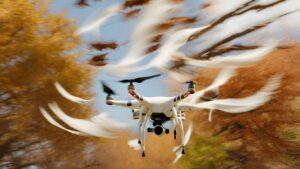
The weight of a drone significantly impacts its ability to withstand wind, with those having more mass generally displaying higher stability under breezy conditions. Nonetheless, the heaviness is not an exclusive determinant in assessing drone resistance against wind.
The dimensions play their part as well – less substantial drones experience fewer setbacks owing to gusty winds. Moreover, consideration of the form and aerodynamic design of a buzzing craft can also impact how it responds when subjected to windy situations. Drones that exhibit sleekness with lower drag coefficients tend toward lesser disturbances from strong drafts.
Both engine potency and thrust stand pivotal for resisting onslaughts presented by fierce gales; drones must generate speed surpassing 50% of that of current airflow factors so they remain stable.
Noteworthy gadgets such as IMU& GPS chips help identify adjustments in lateral placement triggered by air flows while software generating corrective actions towards these deviations ensures the aerial vessel remains unfluctuating during flights abounding prevailing zephyrs{new paragraph}. To ensure your hovering apparatuses are optimally resistant against gale force winds opt for ones that bear considerable heft, a streamlined shape coupled with adequate motor prowess.
Limitations and Precautions for Flying Drones in Strong Winds
Moreover, it is paramount to be cognizant of restrictions and safety measures amid navigating drones in vigorous gusts. Below are vital factors worthy of contemplation:
- Protocols for operating unmanned aerial vehicles in hefty gusts.
- Consistently maintain a precise strategy for unexpected scenarios, like abrupt blasts or loss of command.
- If the breeze proves stronger than what your drone can handle, be ready to bring it down without delay.
- Ensure to keep a secure space between barriers or individuals, preventing possible mishaps.
- Typical errors to circumvent while operating unmanned aerial vehicles in blustery weather.
- If you’re still learning or a novice, steer clear of aviation in breezy weather conditions.
- Refrain from elevating the aerial device excessively amidst vigorous gusts, as its manageability can be undermined.
- Don’t count entirely on the drone’s wind resilience rating; survey the breeze strength before initiating flight.
How to Determine the Wind Resistance Level of Your Drone
To ascertain your drone’s capability to counteract wind, you can consult the details given by its maker. Such data usually encompasses the measure of how resistant a drone is against gusty conditions, which becomes calculated via comprehensive examinations involving multiple levels of breeze intensities. Throughout these evaluations, drones are exposed to differential atmospheres regarding whirlwind velocities so as to judge their steadiness and knack for withstanding fierce winds.
Elements that impart effect on stability when faced with turbulent breezes incorporate aspects like dimensionality and heaviness attributed to drones: those possessing greater physicality in weight or size typically showcase superior capabilities in resisting gales’ impacts. Further attributing factors include aerodynamic making style; and force generated by motors/propulsion systems; while having sensors installed or featuring programmed functions may all incrementally enhance quadcopters’ capacity against blustery weather.
Tips for Flying Drones in Windy Conditions
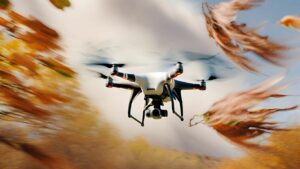
Flying drones when the winds whip up necessitates particular caution and adherence to suggested guidelines for maintaining a steady, secure flight. Below are some advisories on navigating drones amidst blustery conditions:
- Adopt efficient flight methods.
- Whenever feasible, fly against the wind as this can aid in saving battery life.
- Minimizing your altitude and maintaining proximity to the earth’s surface may alleviate intense winds and lessen the power usage of batteries significantly.
- Stay vigilant about gusts or unpredictable shifts in wind direction since they might influence drone stability adversely.
- Estimate speed of prevailing air currents – despite drones lacking built-in velocity sensors for airflow measurements, one could obtain a pretty accurate estimation from meteorological charts, hand-held anemometers, or by reference to localized weather forecasts available online.
- This information aids enormously in determining if measured speeds fall within endurable margins outlined by individual manufacturers regarding their drones’ sustainable capabilities under such conditions
- Selecting UAVs with superior sustainment capability when pitted against strong winds helps immensely too; DJI makes machines capable of handling Level 5 category winds whilst Autel Evo models 1 & 2 are renowned for being robust enough even standing up bravely battling Category-8 gales – offering comparatively constant performance where other brands falter.
Recommended Drones With High Wind Resistance Levels
We suggest DJI drones possessing wind resistance of level 5 and Autel Evo series 1 & 2, equipped with a robust wind resistance capacity of level 8 for operations under substantial windy conditions. They’re designed specifically to hold themselves steady against powerful gusts while maintaining flight stability.
The drone’s potency in combating fierce winds without jeopardizing the equilibrium or duration of its flight is directly contingent on its designated level of wind-resistant ability. Higher tiers mean enhanced resilience against turbulent drafts – being able to withstand them allows the device not only to remain stationed mid-air but also to facilitate uninterrupted smooth flights warranted by control measures.
Thereafter follows a comparative tabulation delineating the aforementioned recommended UAV models along with their individual grades/levels catering towards dealing with particularly breezy situations:
| Drone Model | Wind Resistance Level |
|---|---|
| DJI | 5 |
| Autel Evo 1 | 8 |
| Autel Evo 2 | 8 |
Selecting a drone with superior wind resilience is essential for usage in blustery conditions as it guarantees enhanced steadiness and diminishes the potentiality of wreckage or harm.
Essential Accessories for Flying Drones in Windy Conditions
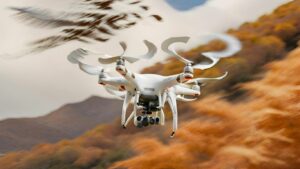
While augmented wind resistance can significantly bolster a drone’s steadiness in heightened windy circumstances, certain pivotal add-ons might bring about improved performance and security for the drone. These additions are meticulously crafted to assist drones in dealing with intense winds while assuring an orderly and governed flight journey.
Below is a breakdown of some crucial drone attachments suitable for operation under heavy wind conditions:
- Rotor Defenders: These tools safeguard the drone’s rotors, ensuring their protection against potent wind gusts and obstacles.
- They also add to the enhancement of overall drone stability during aerial movement.
- Power-Rich Batteries: Powerful breezy conditions necessitate additional power input from a drone’s engines.
- Utilizing batteries with high stored energy ensures that drones possess adequate capacity to withstand destabilizing forces exerted by winds while maintaining balance.
- Remote-Monitored Wind Sensor: This is a mini wind signifier that can be affixed to the controller for drones.
- It provides real-time updates about the direction and speed of prevailing winds, thereby enabling informed decision-making or adjustments in flight-related planning.
Frequently Asked Questions
How Does the Weight of a Drone Affect Its Wind Resistance?
The mass of a drone markedly influences its resistance to wind. Drones carrying more weight typically exhibit greater stability during windy scenarios in opposition to their lightweight counterparts. This results because the supplemental poundage adds further inertia, thus challenging the ability of air currents to displace it from its path.
Still, consideration must be given that a drone’s heft equally impacts how long it can remain aloft. Weightier drones deplete energy at an accelerated rate for flight operations resulting in reduced battery longevity.
Consequently, finding equilibrium between weight and wind fortitude becomes indispensable for maintaining optimal steadiness when faced with breezy settings as well as ensuring maximal time spent flying.
What Role Do Sensors Play in Detecting and Compensating for Lateral Position Shifts Caused by Wind?
Sensors are essential in identifying and negating lateral movement adjustments compelled by wind forces on drones.
Commonly, gyroscopes aid in recording angular speed while also bolstering stability as they pick up changes within the drone’s alignment. The flight controller of a drone can then evaluate this gyroscope-collected data to make alterations as opposed to drift caused by Wind.
Moreover, state-of-the-art drones may integrate GPS chips along with IMU sensors into their system for added sophistication when detecting and counteracting lateral displacements due to windy conditions.
These various kinds of detectors function collectively delivering precise and steady flights even during turbulent weather instances{New paragraph}. There exist several methods which alleviate wind-driven shifts such as aerodynamic outlines paired with potent motors or intricate software algorithm applications.
Can Drones Measure Wind Speed?
Assessing wind velocity in UAV procedures is vital for guaranteeing secure and steady operations. Nevertheless, drones are not fitted with native sensors to gauge the speed of wind accurately. To boost steadiness during breezy weather conditions, elements such as mass, dimensionality, aerodynamic structure motor potency as well software adjustments hold substantial importance.
How Can I Determine the Wind Resistance Level of My Drone?
In order to assess your drone’s capability against wind force, weigh elements like heaviness, dimensions, aerodynamic form factor, engine potency, and the implementation of sensors alongside software systems that adjust for shifts in winds. These factors play a significant role in bolstering the ability of drones to oppose strong gusts while maintaining stability.
Further down the line don’t forget to check out product labeling or guidebook corresponding with your drone – often times it includes valuable insights on its resilience facing windy conditions according to Beaufort chart standards.
It remains critical not to expose drones to gales surpassing their maximum velocity as this could initiate erratic responses leading to catastrophic malfunctions.
What Are Some Essential Accessories for Flying Drones in Windy Conditions?
Crucial accessories for drone wind operation in breezy conditions comprise additional batteries and components, accompanied by a portable case for easy transportation.
Employing strategies like deploying a downdraft flight or moving along the same direction as the breeze can save battery power. Moreover, decreasing altitude coupled with near-ground navigation aids to decrease both the intensity of gusts and energy consumption from your device’s battery.
Moreover, drones that exhibit superior resistance against high winds are advisable; examples may include DJI models boasting Level 5 wind toughness alongside Autel Evo 1 & Evo 2 demonstrating level 8 endurance towards impactful gusts.
Conclusion
Wrapping it up, the knowledge of a drone’s capacity to withstand wind is vital for operating such equipment safely and proficiently. The Beaufort scale offers an important foundation in determining this resistance value; higher ratings on this scale denote enhanced stability even during tough gusty conditions.
Operating drones amid strong winds can be potentially hazardous and tricky but considering elements like weight, measurement parameters, architectural design features, power supply mechanism strength as well and sensory abilities could assist in evaluating how good a drone would hold against windy situations.
Through thorough adherence to safety measures and guidance provided by experts within the field, operators have better chances at averting potential threats thereby making sure their operations remain secure despite turbulent weather.



